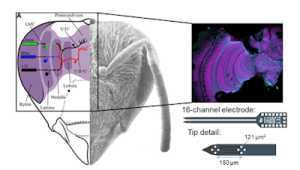As those who attended the Klicka lab talks at last year’s GSS might remember, the family Vireonidae encompasses about 52 species of birds distributed throughout the tropical and temperate Americas. Vireonids are small- to medium-sized arboreal songbirds with a thick and slightly hooked bill. Many species are omnivorous with a predominantly greenish or yellowish plumage. The family has traditionally been divided into 4 genera: Peppershrikes (genus Cyclarhis), Shrike-Vireos (Vireolanius), Vireos (Vireo), and Greenlets (Hylophilus).

With the exception of its starkly colored irides, the White-eyed Vireo (Vireo griseus) is a rather typical vireonid. It breeds in scrubby forest edge and understory in the eastern United States and northeastern Mexico and winters on the Gulf Coast and Caribbean Islands. © David L. Slager, 6 May 2013, Lucas County, Ohio, USA.
Until now, the few molecular phylogenetic studies examining the history of Vireonidae have sampled only a small number of taxa, preventing detailed inference about the family’s evolutionary history. By contrast, we were able to sample mitochondrial and nuclear genes from 221 individuals representing 46 of 52 vireonid species, enabling us to break much new ground in understanding the evolutionary history of this important clade. Among several key results we (including fellow biograd C.J. Battey!) recently published in Molecular Phylogenetics and Evolution was our finding that the New World Vireonidae is monophyletic group, consistent with a single colonization of the Americas from an Asian ancestor. We also found preliminary evidence for the existence of several cryptic species in the Neotropics and noted that tropical vireonids contain greater intraspecific genetic diversity on average than their temperate counterparts. This trend is consistent with data from other bird families, and suggests that regional taxonomic bias or biological processes such as higher tropical speciation rates may be driving the pattern. Our phylogeny contradicted the traditional taxonomy of Vireonidae in important ways. Most notably, we found that the 15 greenlet species in the genus Hylophilus (sensu lato) are not closely related to each other but fall into 4 different clades. In an attempt to clean up this taxonomic mess, we published a follow-up paper in Zootaxa revising the genus-level taxonomy of the greenlets so that genera reflect monophyletic groups. We proposed keeping the pale-eyed, scrub-dwelling greenlets in Hylophilus, moving the dark-eyed, canopy-dwelling greenlets to the old genus Pachysylvia, moving Tepui Greenlet to Vireo, and transferring the unique understory-dwelling Tawny-crowned Greenlet into the new genus Tunchiornis.

The canopy-dwelling Rufous-naped Greenlet (Hylophilus semibrunneus) is a core member of mixed-species foraging flocks in subtropical forests of the northern Andes. Our revised taxonomy places it in the genus Pachysylvia to reflect the fact that it and other canopy-greenlets are only distantly related to the scrub- and understory-dwelling greenlets. © David L. Slager, 7 February 2011, Jericó, Antioquia, Colombia.
Switching topics away from vireos, a molecular phylogeny of the New World sparrows published in the Klicka lab in early 2014 showed that the American Tree Sparrow (Spizella arborea) is not related to the other species of Spizella sparrows, but rather represents its own lineage with a long, independent evolutionary history. In our Zootaxapaper, we reviewed the taxonomic and phylogenetic placements of the American Tree Sparrow to date and described a new genus, Spizelloides, for the American Tree Sparrow to allow modern taxonomies to more closely reflect its evolutionary relationships. That’s all for now. You’ll have to come to GSS this spring to hear what’s up next!
–Dave
References
Slager, D.L., Battey, C.J., Bryson, R.W. Jr., Voelker, G. and J. Klicka. 2014. A multilocus phylogeny of a major New World avian radiation: The Vireonidae. Molecular Phylogenetics and Evolution 80:95-104.
Slager, D.L. and J. Klicka. 2014a. A new genus for the American Tree Sparrow (Aves: Passeriformes: Passerellidae). Zootaxa 3821:398-400.
Slager, D.L. and J. Klicka. 2014b. Polyphyly of Hylophilus and a new genus for the Tawny-crowned Greenlet (Aves: Passeriformes: Vireonidae). Zootaxa 3884:194-196.


